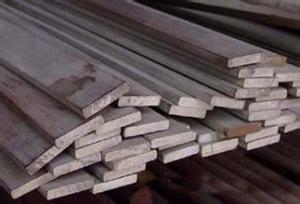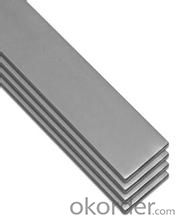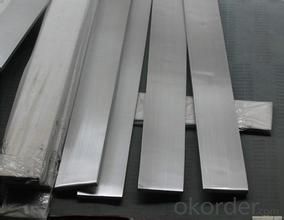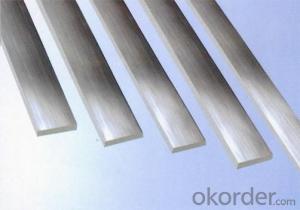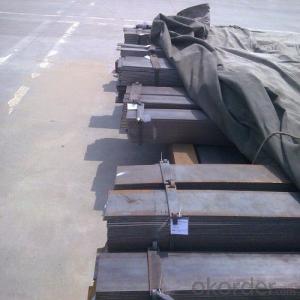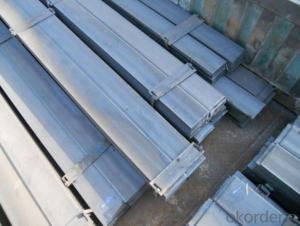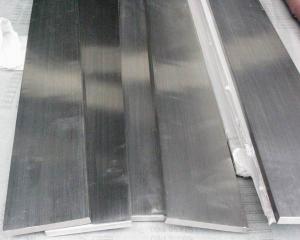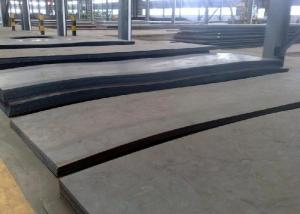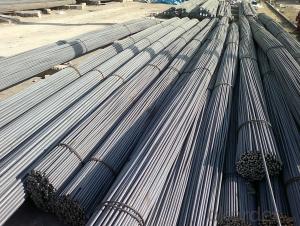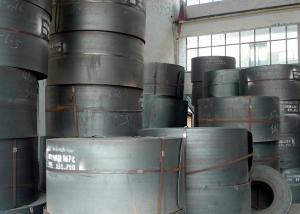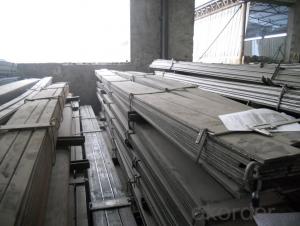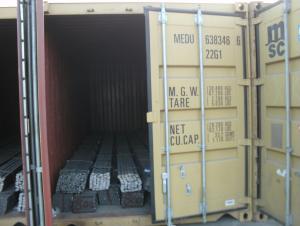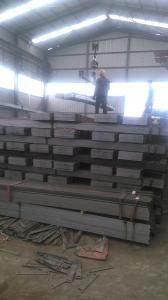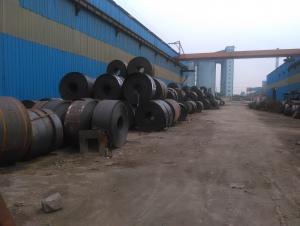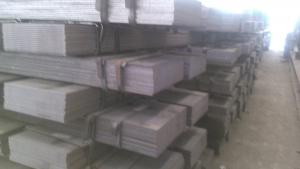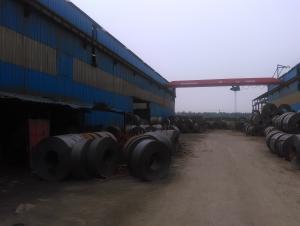Flat Steel wide Hot Rolled wide 100mm*18mm*6m
- Loading Port:
- Tianjin
- Payment Terms:
- TT or LC
- Min Order Qty:
- 25 m.t.
- Supply Capability:
- 10000 m.t./month
OKorder Service Pledge
OKorder Financial Service
You Might Also Like
Product Description:
OKorder is offering Flat Steel wide Hot Rolled wide 100mm*18mm*6m at great prices with worldwide shipping. Our supplier is a world-class manufacturer of steel, with our products utilized the world over. OKorder annually supplies products to European, North American and Asian markets. We provide quotations within 24 hours of receiving an inquiry and guarantee competitive prices.
Product Applications:
Flat Steel wide Hot Rolled wide 100mm*18mm*6m are ideal for structural applications and are widely used in the construction of buildings and bridges, and the manufacturing, petrochemical, and transportation industries.
Product Advantages:
OKorder's Flat Steel wide Hot Rolled wide 100mm*18mm*6m are durable, strong, and resist corrosion.
Main Product Features:
· Premium quality
· Prompt delivery & seaworthy packing (30 days after receiving deposit)
· Corrosion resistance
· Can be recycled and reused
· Mill test certification
· Professional Service
· Competitive pricing
FAQ:
Q1: Why buy Materials & Equipment from OKorder.com?
A1: All products offered byOKorder.com are carefully selected from China's most reliable manufacturing enterprises. Through its ISO certifications, OKorder.com adheres to the highest standards and a commitment to supply chain safety and customer satisfaction.
Q2: How do we guarantee the quality of our products?
A2: We have established an advanced quality management system which conducts strict quality tests at every step, from raw materials to the final product. At the same time, we provide extensive follow-up service assurances as required.
Q3: How soon can we receive the product after purchase?
A3: Within three days of placing an order, we will begin production. The specific shipping date is dependent upon international and government factors, but is typically 7 to 10 workdays.
Q4: What makes stainless steel stainless?
A4: Stainless steel must contain at least 10.5 % chromium. It is this element that reacts with the oxygen in the air to form a complex chrome-oxide surface layer that is invisible but strong enough to prevent further oxygen from "staining" (rusting) the surface. Higher levels of chromium and the addition of other alloying elements such as nickel and molybdenum enhance this surface layer and improve the corrosion resistance of the stainless material.
Q5: Can stainless steel rust?
A5: Stainless does not "rust" as you think of regular steel rusting with a red oxide on the surface that flakes off. If you see red rust it is probably due to some iron particles that have contaminated the surface of the stainless steel and it is these iron particles that are rusting. Look at the source of the rusting and see if you can remove it from the surface.
Images:

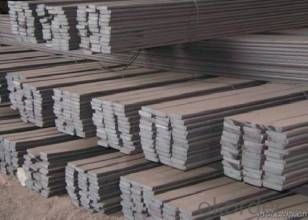
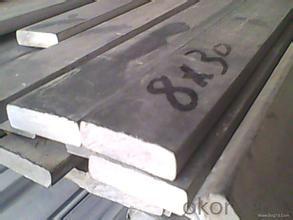
- Q: What are the common standards or specifications for steel flat bars?
- There are several common standards and specifications for steel flat bars, which help ensure consistency and quality in their production and usage. Some of the most widely recognized standards include: 1. ASTM A36/A36M: This standard specifies the requirements for carbon structural steel, including steel flat bars. It covers various dimensions, chemical composition, mechanical properties, and tolerances. 2. ASTM A108: This specification outlines the requirements for carbon steel bars, including flat bars, used in general structural purposes. It covers different grades and classes of carbon steel, as well as their chemical composition, mechanical properties, and tolerances. 3. ASTM A666: This standard specifically addresses the requirements for austenitic stainless steel flat bars. It provides specifications for chemical composition, mechanical properties, dimensions, and surface finishes. 4. EN 10058: This European standard specifies the dimensions, tolerances, and technical delivery conditions for hot-rolled flat steel bars. It covers various steel grades and provides guidelines for the manufacturing process and surface quality. 5. JIS G3101: This Japanese standard defines the general requirements for hot-rolled steel plates, sheets, and strips, including flat bars. It includes specifications for chemical composition, mechanical properties, dimensions, and tolerances. It is important to note that specific industries or applications may have additional requirements or standards for steel flat bars. For example, the construction industry often refers to specific local building codes or standards, while the automotive industry may have its own proprietary specifications. Therefore, it is essential to consider the intended use and consult the relevant standards and specifications to ensure compliance and suitability for a particular project or application.
- Q: Can steel flat bars be used for construction projects?
- Yes, steel flat bars can be used for construction projects. Steel flat bars are versatile and widely used in the construction industry due to their strength and durability. They are commonly used for various applications such as supports, braces, frames, and structural components in buildings, bridges, and infrastructure projects. Steel flat bars provide reliable structural support and are known for their high load-bearing capacity, making them ideal for construction purposes. Additionally, their uniform shape and size make them easy to work with, allowing for efficient installation and fabrication. Overall, steel flat bars are a popular choice in construction due to their strength, durability, and versatility.
- Q: Earthing flat steel and earthing main line
- The flat steel is connected to the ground system, and the grounded line is connected to the protected equipment
- Q: Can steel flat bars be used for decorative purposes?
- Yes, steel flat bars can be used for decorative purposes. They can be shaped, bent, and finished to create unique designs and patterns that add aesthetic appeal to various architectural and interior design elements.
- Q: Can steel flat bars be used as support beams?
- Indeed, support beams can be made from steel flat bars. Steel is renowned for its robustness and endurance, rendering it an ideal substance for structural reinforcement. In construction and engineering endeavors, steel flat bars are frequently utilized to furnish support and fortification. They can function as beams, sustaining substantial burdens and uniformly distributing weight throughout a structure. Furthermore, steel flat bars can be conveniently fabricated and trimmed to desired sizes, thereby exhibiting versatility for diverse applications. All in all, when it comes to support beams in construction undertakings, steel flat bars undeniably present themselves as dependable and efficient options.
- Q: What is the representation of flat steel?
- In use, it has advantages over steel platesFlat steel adopts negative deviation rolling, but according to actual weight, the utilization ratio of steel plate is 1~5 percentage points higher than that of steel plate.Flat can according to user needs, set the thickness, width and length of production, for the user to reduce the cut and save processes, reducing labor, material consumption, but also reduce the loss of raw materials processing, time saving, material saving. Products have been specialized in steel structure manufacturing, machinery manufacturing, automotive industry, mining machinery, lifting machinery and other industrial materials.
- Q: What are the different methods of surface hardening for steel flat bars?
- There are several different methods of surface hardening for steel flat bars, each offering unique advantages and applications. Some of the most common methods include: 1. Flame Hardening: This process involves heating the surface of the steel flat bar with a flame and then quenching it rapidly, resulting in a hardened outer layer while retaining a tough core. Flame hardening is suitable for larger flat bars and offers good wear resistance. 2. Induction Hardening: In this method, an alternating electromagnetic field is used to heat the surface of the steel flat bar, followed by quenching. Induction hardening provides precise control over the hardened depth and is ideal for flat bars with complex geometries or smaller sizes. 3. Nitriding: Nitriding involves exposing the steel flat bar to a nitrogen-rich environment at elevated temperatures. This process forms a hard nitride layer on the surface, providing excellent wear and corrosion resistance. Nitriding is commonly used for flat bars that require superior surface hardness. 4. Carburizing: Carburizing involves heating the steel flat bar in a carbon-rich environment, allowing carbon atoms to diffuse into the surface. The part is then quenched to achieve hardness. Carburizing offers high wear resistance and is suitable for flat bars that require a hardened surface layer. 5. Carbonitriding: This method combines the benefits of both carburizing and nitriding. The steel flat bar is heated in a nitrogen-rich and carbon-rich atmosphere, resulting in a hard surface layer with improved wear and corrosion resistance. Carbonitriding is commonly used for flat bars that require a combination of hardness and toughness. 6. Laser Hardening: Laser hardening utilizes a high-energy laser beam to heat and rapidly cool the surface of the steel flat bar, creating a hardened layer. This process offers precise control over the hardened area and is suitable for flat bars with intricate designs or localized hardening requirements. Each surface hardening method has its own advantages and limitations, and the choice depends on the specific requirements of the steel flat bar application, such as desired hardness, wear resistance, and dimensional complexity.
- Q: Are steel flat bars suitable for food processing applications?
- Depending on the specific requirements and conditions, steel flat bars may be appropriate for use in food processing applications. Steel is a strong and durable material that can withstand high temperatures, pressure, and harsh cleaning agents commonly found in food processing facilities. Before using steel flat bars in food processing, certain factors should be considered. The type of steel used is crucial, with stainless steel being the preferred choice for food processing applications. Stainless steel, particularly grades 304 or 316 with high corrosion resistance, offers excellent protection against corrosion, staining, and bacterial growth, ensuring hygienic conditions. The surface finish of the steel flat bars is also important. A smooth and polished finish is preferred to prevent the accumulation of dirt, bacteria, and other contaminants. This promotes cleanliness and helps prevent cross-contamination. Moreover, it is essential that the steel flat bars are free from any coatings or finishes that could release harmful substances into the food during processing. Compliance with food safety regulations and certifications is necessary to ensure the steel used is safe for food processing. In summary, steel flat bars can be suitable for food processing applications if they are made from stainless steel with high corrosion resistance, have a smooth surface finish, and meet food safety regulations. Consulting with experts or adhering to industry standards is recommended to ensure the suitability of steel flat bars for specific food processing applications.
- Q: Can steel flat bars be used for creating partitions or room dividers?
- Yes, steel flat bars can indeed be used for creating partitions or room dividers. Their strong and rigid nature makes them suitable for providing structural support and stability. Additionally, steel flat bars can be welded, bolted, or attached in various ways to create a sturdy and durable room divider.
- Q: Are steel flat bars available in different surface hardness options?
- Yes, steel flat bars are available in different surface hardness options. The hardness of steel flat bars can be modified through various heat treatment processes to achieve different levels of hardness, such as annealing, quenching, and tempering. This allows for customization based on specific application requirements.
Send your message to us
Flat Steel wide Hot Rolled wide 100mm*18mm*6m
- Loading Port:
- Tianjin
- Payment Terms:
- TT or LC
- Min Order Qty:
- 25 m.t.
- Supply Capability:
- 10000 m.t./month
OKorder Service Pledge
OKorder Financial Service
Similar products
Hot products
Hot Searches
Related keywords
